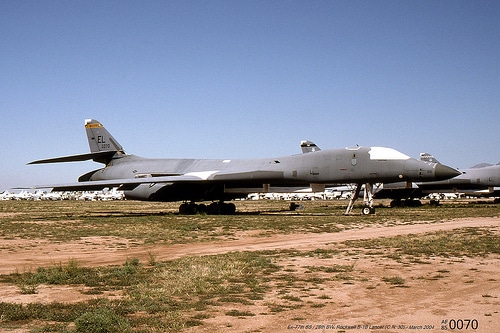B-1B with its Nose to the Ground
On the 5th of October in 1989, a B-1B Lancer departed Dyess Air Force Base with four crew on a routine training flight. Three hours later, the flight crew discovered that the aircraft had a hydraulics fault. As they came in to land at Dyess Air Force Base in Texas, the front landing gear failed to lower.

They circled the airfield for four hours, twice being refuelled by an airborne tanker, as they struggled to lower the nose wheel. Supporting the crew on the ground were military personal and mechanics for the aircraft manufacturer; however they were unable to resolve the issue.
The Air Force had the flight crew fly a further three hours and over 1,000 miles to Edwards Air Force Base, where they circled for another two hours. Air Force officials decided to land the plane on Rogers Dry Lake. Rogers Dry Lake bed is a natural clay runway and is the site of most of the Space Shuttle landings (see Brent’s comment below – it looks like I got this wrong).
The $280 million B-1B Lancer is a four-engine supersonic bomber which is 146 ft (44.5 m) long and a wingspan of 137 ft (41.8m). This is almost the size of a DC-10.
The B-1B has a maximum speed of Mach 1.25 (721 knots, 830 mpg, 1,340 km/h) at 50,000 feet and a range of 6,500 nautical miles. A total of 100 B-1Bs were produced.
The bomber made several low-level passes, which confirmed that the landing gear was still partially retracted. They attempted to jar the nosewheel loose with a touch and go. When that failed, they made a final approach onto the lake at 18:15 local time.
This newly released video of the landing was emailed to me by a reader and it is simply amazing.
None of the crew was hurt and the aircraft unbelievably only suffered minimal damage.
Once on the ground, one of the pilots told the press, “It’s been a great day for flying, except for a few glitches.”








It’s amazing how long the roll out lasted after the nose touched down. That must have seemed like eternity for the crew.
A minor correction: most shuttle missions landed at the Kennedy Space Center in Florida (78). Of the ones that landed at Edwards AFB (54), fewer than half used the lake bed. The rest landed on more traditional runway surfaces. Additionally, one mission landed on a lake bed at White Sands, NM. Both lost missions were slated to land at Kennedy as well.
Thanks Brent, I added a pointer to your comment. I might be a little bit biased because I saw a space shuttle landing there. :D
Pretty amazing seeing how much the fuselage flexes as the nose touches the lake bed! Great find!
I don’t want to sound like sour grapes, but it always amazes me to read how a crew who had to land an aircraft with a not fully extended landing gear are hailed as “heroes”.
A landing with the undercarriage, or part thereof, not fully extended will inevitably result in damage of some kind to the aircraft.
If captured on film or video it looks spectacular.
But it rarely results in a life-threatening situation. In most cases, everyone walks away from it unhurt.
The crew in this posting did a very good job.No doubt about it. But then, most pilots do when it happens to them.